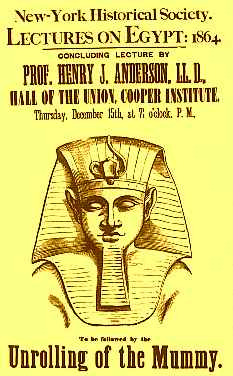pop up description layer
HOME
Cryptozoology UFO Mysteries Aviation Space & Time Dinosaurs Geology Archaeology Exploration 7 Wonders Surprising Science Troubled History Library Laboratory Attic Theater Store Index/Site Map Cyclorama
Search the Site: |
|
Mr. Mummy Goes to Hollywood
The first mummy horror stories weren't the work of Hollywood producers, or even 19th century gothic novelists. They came from ancient Egypt itself. Several of these tales involve the historical figure of Setne Khamwas who was a high priest and a son of Pharaoh Ramses II. In one story Khamwas sets out to find the forbidden and magical Book of Thoth, but is challenged by the mummy of Naneferkaptah who protects it. Khamwas steals it anyway, but winds up returning it to the mummy's tomb when the misfortunes the book brings him are too painful. In the 18th and 19th centuries mummies first figured in entertainment not through stories, but as spectacle when mummy "unrollings" became a fad in Europe and America. Johnann Blumenbach, a German physician and anthropologist, unwrapped dozens of mummies across England in 1792. At first only the mummy's owners and a few friends were present at these gatherings, but then larger groups viewed the unrollings. Blumenbach found that many of the mummies that had been sent back to Europe were fakes sold to travelers by unscrupulous antiques dealers in Egypt. In 1833 Thomas Pettigrew, who became the most
famous of the unrollers, purchased a mummy in an auction for 23
British pounds. He'd already unrolled one mummy more than ten
years before for a friend. The one he bought he took to the lecture
hall of Charing Cross Hospital where Pettigrew was an anatomy
professor. There was a full house the night Pettigrew did the
unwrapping and soon unwrappings became a full-fledged fad. Egypt
fascinated the English and the mummy unrollings became social
events. Pettigrew was soon unwrapping to standing-room only crowds
in such places as the lecture hall of the Royal Institute. In
1834 Pettigrew gave a 6 lecture course of Egyptian Antiquities
culminating in the unwrapping of an actual mummy. Front seats
were sold for a guinea, back seats for half a guinea.
By the end of his illustrious mummy unrolling career, Pettigrew had unwrapped dozens of mummies. Despite the showmanship involved, Pettigrew was a careful observer and added much to the scholarly study of mummies (not something every unroller could claim). His final performance was not to unroll a mummy, but do quite the opposite. In accordance with the wishes of the Duke of Hamilton, he turned the Duke into a mummy upon the Duke's death. It was during the unwrapping fad of the 19th century that the first mummy novel appeared. In 1857 Theophile Gautier wrote Romance of a Mummy. In this story two archaeologists discover a tomb and in it the mummy of a beautiful girl. Within the sarcophagus they find a paper telling of the story of the mummy's love-life which becomes the main plot of the book. Arthur Conan Doyle (of Sherlock Holmes fame), produced two short stories with sinister mummies figuring as major characters: The Ring of Thoth and Lot 249. At about the same time Bram Stoker wrote his novel The Jewel of the Seven Stars. Bram Stoker is famous today as the inventor of the fictional Count Dracula. His Jewel of the Seven Stars is a lessor-known book, but it clearly added much to the mummy horror genre. In the book, the tomb of an Egyptian Queen is found. Her mummy is transported to England by an archaeologist. Unfortunately the mummy's Ka, or spirit, takes possession of the scientist's beautiful daughter. The queen wishes to reanimate her dead body, but must find the Jewel of the Seven Stars to do it. Mummy films started appearing almost as soon as the motion picture camera was invented. The Mummy of King Ramses was made in France in 1909. The most famous mummy movie is clearly The Mummy made in 1932 by Universal Studios. The film starred Boris Karloff, who just shortly before had played the title monster in Frankenstein. It took eight hours for Karloff to be made up for his mummy scenes. The effect was worth it, and when Karloff appeared on the set for shooting, the whole crew gasped. The film, riding the wave of interest from the discovery of King Tutankhamen's tomb, was very successful. This lead to the making of a number of sequels including The Mummy's Hand, The Mummy's Tomb, The Mummy's Ghost and The Mummy's Curse. None rose to the quality of the original film, however. In 1955 Universal Studios took the genre in another direction with Abbott and Costello Meet the Mummy. This was part of a series of successful horror parody films made by the great comedy team of Bud Abbott and Lou Costello. While not quite up to their best film in the series, Abbot and Costello Meet Frankenstein, it is still easily the best mummy comedy ever made.
In England, Hammer films produced a series of mummy films starting in 1959. They included The Mummy, Curse of the Mummy's Tomb, The Mummy's Shroud, and Blood from the Mummy's Tomb. Mummies came to life again in 1999 in the remake of The Mummy starring Brendan Fraser. This production was less of a horror film and more of an Indiana Jones-style adventure. The Mummy, now powered by the best in computer graphics effects, looked great. The story followed closely to the original 1932 films plot. The film was successful enough to warrant a sequel, however, that audiences enjoyed in 2001. Copyright Lee Krystek, 2000. All Rights Reserved. |
|
Related Links |
|
}
|




